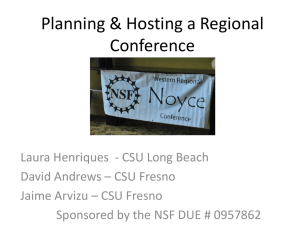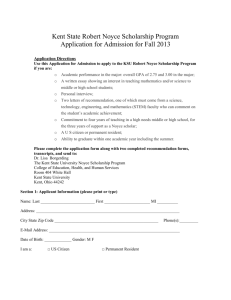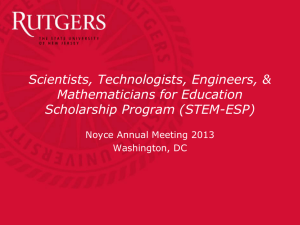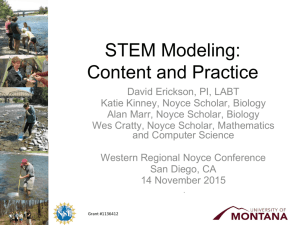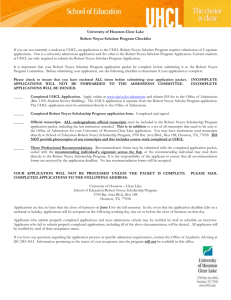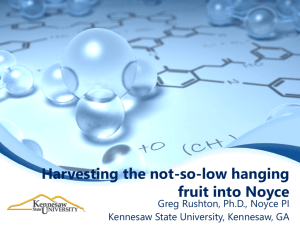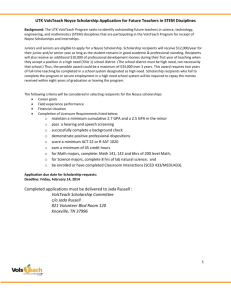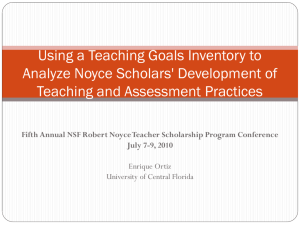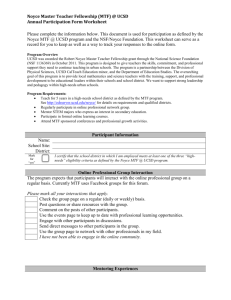Evaluation Report II: The Robert Noyce Scholarship Program at CSUB
advertisement
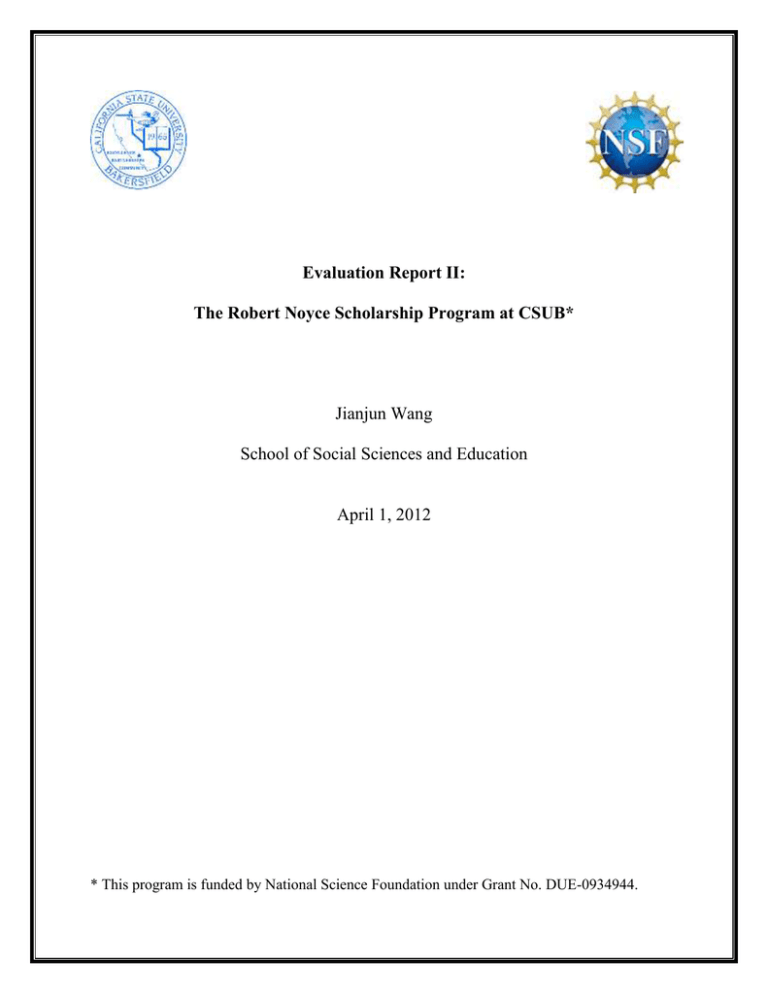
Evaluation Report II: The Robert Noyce Scholarship Program at CSUB* Jianjun Wang School of Social Sciences and Education April 1, 2012 * This program is funded by National Science Foundation under Grant No. DUE-0934944. 2 Evaluation Report II: The Robert Noyce Scholarship Program at CSUB Table of Content Features of the Noyce Program at CSUB ………………………………………... 3 Effective Recruitment Strategies ……...………..…………………...……. 6 Preparation for Teaching at High-Needs Schools ……….……………….. 9 Mentorship to Support Scholar’s Progress …………………………………….. 10 Field-based Advising …………………… .…...………………….……… 11 Depth of Learning ………………………....……………………………. 13 Improvement of Student Achievement ………………………………………… 16 Intrinsic Understanding of Teaching Expectation .........………………….. 17 Extrinsic Support for Student Learning ……...…………………………. 19 Tracking Mechanism for Data-Driven Decisions ………………...……………. 21 Recommendation ………………………………………………………………... 22 Conclusion ……………………………………………………………………… 23 References ……………………………………………………………………… 24 Appendices 1. Noyce Scholar Survey …………..……………………………………. 29 2. Agenda of Noyce Scholar Meetings …………………………………. 31 3. Instrument from an NSF-Sponsored Evaluation Site ………………... 33 3 Evaluation Report II: The Robert Noyce Scholarship Program at CSUB The Robert Noyce Scholarship program was authorized under the National Science Foundation (NSF) Authorization Act of 2002 (P.L. 107-368) to increase the number of qualified science and mathematics teachers in high-needs school districts. California State University, Bakersfield (CSUB) received the NSF funding to recruit students majoring in science, technology, engineering, and mathematics (STEM), and institutionalized special programs to enhance competency of those Noyce Scholars in STEM teaching. Features of the Noyce Program at CSUB Andreas Gebauer, chair of the chemistry department, has been the Principal Investigator for the Noyce program at CSUB since 2009. Under his leadership, the Noyce advisor team includes a group of mathematics and science professors to mentor teacher candidates in STEM areas. Among them is Professor Kamel Haddad who concurrently serves as a Noyce mathematics advisor and the associate dean of the School of Natural Sciences and Mathematics (NS&M). As he acknowledged, “The main function of the CSU system is to prepare teachers”[1]. Built on the strong institutional commitment, CSUB has established a blended program in mathematics that allows Noyce Scholars to graduate with teaching credentials in four years. In contrast, “Most campuses in the CSU system don’t have this blended program and students must spend five years to accomplish their undergraduate studies to become a math teacher” (Popa, 2008, p. 9). The unique program feature has played a very important role for Noyce scholar recruitment and retention. As indicated in an NSF-sponsored evaluation report, the speed of training and the quick entrance to the classroom were more important than money in recruiting individuals to teaching (Liu, Johnson, & Peske, 2004). ______________ [1] See http://www.csub.edu/csubnews/cstoday/winter08/insideCSUB_w08.pdf 4 The Noyce program at CSUB represents a collaborative effort between NSF and the state university to address the increasing shortage of STEM teachers across the local high-needs school districts. Bakersfield is the seat of Kern County that has been ranked as one of the least educated metropolitan areas in the nation (Zumbrun, 2008). The latest census report indicated that Kern County was the fastest growing county across California over the past decade (Wenner & Barrientos, 2011). To match the population growth, Noyce Scholar recruitment has been one of the primarily focuses since the last year. As a result, the number of Noyce Scholars is expanded from seven in last year to 18 this year. Accompanied with the quantity increase is a persistent effort to maintain the program quality – a minimum 3.0 GPA has been sustained by this program since its inception[2]. The ongoing progress is consistent with the intellectual merit delineated in the original proposal for the Noyce program setup: This program will contribute to the knowledge of how to best recruit, prepare and retain teachers in the science, technology, engineering, and mathematics (STEM) fields. It will a) identify and investigate strategies that are effective in the recruitment of Noyce scholars; b) describe and assess the Scholars’ progress and success as they fulfill their teaching service obligations; c) analyze the Noyce program’s effectiveness in improving teacher quality and student achievement; and d) support data-driven decisions in order to strengthen the program and its outcomes over time. The purpose of this report is to examine effectiveness of the Noyce program, and thus, promote the designated intellectual merits on those four fronts. To support the evaluation effort, empirical results are grounded on both quantitative and qualitative information from Noyce Scholars, STEM advisors, and the Program Coordinator (Ms. ______________ [2] Other institutions have lowered the GPA requirement to a level below 3.0 (e.g., www.uncp.edu/soe/noyce/Robert_Noyce_2007-08.pdf and www.coe.fsu.edu/content/download/68128/754248). 5 Medina) to strengthen propriety of the data gathering. Program features are disentangled through triangulation of the personnel feedback and document analyses to enhance accuracy of the reporting. In the quantitative part, consistency of the survey responses is reflected by a reliability index, as measured by Cronbach’s The value has reached 0.91 at the upper bound of its 95% confidence interval for the subscales that allow free choices of multiple options (see Appendix 1). In addition, concurrent validity of the survey outcomes has been established by an extensive coverage of the content mapping across five scholar surveys from an NSFsponsored website for Noyce program evaluation[3]. While the same evaluation standards were maintained since the last report, new instruments have been developed to track feedback of Noyce Scholars at various stages of their learning/teaching process. The data gathering effort encompasses all 18 Noyce scholars recruited at CSUB, plus one former scholar who dropped from the program for personal reasons a year ago. In the previous report, that person was noted for working in the STEM field with a job in the business sector. Except for that unique case, all Noyce Scholars have been retained in the program for STEM teacher preparation. The evaluator, JJ Wang, works at a different academic division that has no administrative link to the grant team. Besides maintaining the external objectivity, he actively gathered internal information from transcript records, phone interviews, and contextual evidences to articulate utility of the findings for multiple stakeholders. In modeling after the best practices, the final report includes a feasible recommendation from an extensive review of the existing evaluation reports, application forms, agenda from past Noyce Scholar meetings, and articles disseminated from other Noyce program sites. Altogether this report adheres to the Utility, Feasibility, Propriety, and Accuracy standards endorsed by the American National Standards Institute ______________ [3] http://www.cehd.umn.edu/EdPsych/NOYCE/Reports/Surveys/U%20of%20MN%20Scholar%20Surveys.html 6 (ANSI) and 17 North American professional organizations (Program Evaluation Standards, 2010; Yarbrough, Shulha, Hopson, & Caruthers, 2010). Effective Recruitment Strategies Labor market theories have been cited to analyze recruitment, where the choice to teach depends on if teaching is the most attractive option currently available to an individual (e.g., Guarino, Santibanez, & Daley, 2006). CSUB is fortunate to have a group of exemplary advisors to attract Noyce Scholars into the field of STEM teaching. The Principal Investigator, Andreas Gebauer, was the awardee of CSUB Faculty Leadership and Service Award in 2010. Another Noyce Advisor, Dirk Baron, won the CSUB Faculty Research Award in 2010-11. Kamel Haddad was a recipient of the Millie Ablin Excellence in Teaching. Carl T. Kloock has been recruited into the doctoral faculty to serve an Ed.D. program jointly sponsored by CSUB and CSU, Fresno. Besides those esteemed professors in STEM fields, Dr. Ron Hughes has accumulated professional experiences in science education for more than two decades. Noyce Scholars are required to meet with their assigned Noyce faculty advisor once per quarter to discuss their course schedule and ensure their program completion. The effective mentorship has been clearly demonstrated in the interview findings. One Noyce Scholar (CSUB Student ID: 900186827) reported, I cannot think of anything that NOYCE has not already provided me. NOYCE has been a great experience and I appreciate the individual help I get from my advisors. My advisor helps me with my educational planning and also with school work. Another Scholar (CSUB Student ID: 000522470) concurred, I’m not sure what improvements could be made. I enjoy the way that it is, meeting once or twice a quarter and hearing speakers. Dr. Hughes is extremely informative and willing 7 to help, I feel that I have all the advice I could ever ask for at my finger tips. Since STEM subject competency is generally needed in the labor force development, the Noyce scholarship program has to compete against other employment opportunities outside of the teaching field. In comparing student ability between teaching and non-teaching tracks, the Noyce Scholars unanimously reported that STEM majors in the teaching track were either better or as good as those of non-teaching track (Figure 1). Figure 1: Ability Comparison of STEM Majors Between Teaching and Non-Teaching Tracks Although research literature indicates that college students of highest ability tend not to go into teaching (Ballou, 1996; Gitomer, Latham, & Ziomek, 1999; Henke, Chen, Geis, & Knepper, 2000; Podgursky, Monroe, & Watson, 2004), quality of the Noyce advisors seems to have played an important role in attracting STEM majors to the teaching track. Perhaps because all of the Noyce Advisors are males, Figure 1 also showed stronger confidence among the male scholars on the ability rating. Beyond the faculty capacity building for scholar recruitment, researchers generally believed that STEM programs should constantly enhance personal commitment of STEM majors on the teaching track (see Johnson, Berg, & Donaldson, 2005; Ingersoll, 2002, 2003; Smith & Ingersoll, 2004). Darling-Hammond and Sykes (2003) examined impact of scholarship support, 8 and singled out the enhancement of commitment as an effective strategy. Liou, Desjardines, and Lawrenz (2010) reported that “recipients who had already decided to become a teacher before hearing about the scholarship were more likely to be in the highly committed to teaching and high-needs cluster” (p. 138). Figure 2 showed that only 21% (or 4 out of 19) of the Noyce Scholars have made their decisions on teaching before college age. Two of 19 scholars were still undecided, and there was no gender biasness within the undecided group. Figure 2: Teaching Commitment of Noyce Scholars To recruit STEM students with strong teaching commitment, the Noyce program hired a program director (Andrea Medina) this year to work with those STEM majors who already showed a strong interest in K-12 teaching. With her director roles for three other programs in STEM education[4], Ms. Medina was able to foster communications with various potential applicants across School of Natural Sciences and Mathematics. For instance, one of the programs was Math and Science Teacher Initiative (MSTI) funded by the CSU Chancellor's office. The information exchange with MSTI students has led to recruitment of 47% (9 out of 19) of the Noyce Scholars this year. When reporting reasons for their application, 68.4% of the ______________ [4] see program sits at www.csub.edu/mti, www.csub.edu/crest, and www.csub.edu/stem. 9 Noyce Scholars indicated their benefit from Ms. Medina’s outreach effort across multiple programs (see Table 1). Table 1 is based on survey responses from 19 Noyce Scholars since the program inception. It was noted on page 11 of the last evaluation report that “The existing effort should be maintained to expand the Noyce scholar pool from 7 (the realized number) to 12 (the expected number) in the next year”. Due to the program networking, the recruitment gap has been completely filled out this year. Table 1 showed that the coordinated effort from the program director was much more effective than any other approaches adopted in the past. Table 1: Percent of Noyce Scholars Being Reached by Methods of Recruitment (N=19) Method of Recruitment The NOYCE director (Ms. Medina) Academic advisor Flyer or poster CSUB Noyce Website Other NOYCE scholars CSUB homepage Course instructor Class visitor/announcement STEM professor recommendation Recommended by a current participant Other STEM scholarship opportunities Newspaper article or advertisement Percent 68.4 42.1 36.8 36.8 26.3 15.8 10.5 10.5 5.3 5.3 0.0 0.0 Preparation for Teaching at High-Needs Schools School districts with high needs typically meet one or more of the following criteria: (A) It has at least one school in which 50 percent or more of the enrolled students are eligible participation in the free and reduced price lunch program established by the Richard B.Russell 10 National School Lunch Act (42 U.S.C.1751 et seq.). (B) It has at least one school in which: (i) more than 34 percent of the academic classroom teachers at the secondary level (across all academic subjects) do not have an undergraduate degree with a major or minor in, or a graduate degree in, the academic field in which they teach the largest percentage of their classes; or (ii) more than 34 percent of the teachers in two of the academic departments do not have an undergraduate degree with a major or minor in, or a graduate degree in, the academic field in which they teach the largest percentage of their classes. (C) It has at least one school whose teacher attrition rate has been 15 percent or more over the last three school years. In comparison to other schools, high-needs schools imposed more challenges for teachers, particularly these newly graduated from the Noyce scholarship program. Hence, given options, not all the teacher candidates would treat high-needs schools as their preferred choice (see Table 2). As Coladarci (1992) and Day, Elliot, and Kington (2005) suggested, it takes lifelong learning and strong mentorship to retain STEM teachers for those high-needs schools. Table 2: Percent of Noyce Scholars with Preferred Choices of Teaching Career Choices Percent I would like to be a STEM teacher at a high-needs school I would rather not teaching I might teach in the STEM field, but not at a high-needs school I might teach, but not in the STEM field 68.4 10.5 5.3 0.0 Mentorship to Support Scholar Progress The Noyce scholarship program provides funding to meet critical needs of K-12 teachers 11 in STEM education. CSUB has designated STEM professors as the program advisors to monitor the progress of each Noyce Scholar toward establishing a teaching career in elementary and secondary education. Accordingly, field-based advising and depth of learning become the twofold emphases to justify the return on federal funding. Field-based Advising Issues from the teaching field could impact retention of Noyce Scholars at high-needs schools. Liou, Desjardines, and Lawrenz (2010) pointed out, “These scholars may have initially decided to apply for the scholarship not necessarily because of their interest in teaching but because they were high-ranking STEM majors and thought they would be competitive for this prestigious scholarship” (p. 138). To avoid attrition of the Noyce Scholar group during their teaching practice, field-based advising has been featured in the program mentorship to connect credential classes with what really works at a high-needs school. As one scholar (CSUB Student ID: 000121693) reported, Becoming a teacher when I did, I have to say the best way to prepare for working in high needs schools is actual working in a high needs school. I felt as though, while it had good intention, the credential classes did little to aid in my effectiveness as an educator. Actually being in the field and participating in the education of students, listening to what THEY want in the teachers, and listening and applying the suggestions of others were what made me prepared. The field-based experiences are enriched through invitations of guest speakers at Noyce Scholar meetings. The CSUB program faculty carefully selected guest speakers who were effective practitioners and professional leaders in teaching high-needs schools. As demonstrated by the meeting agenda in Appendix 2, Noyce Scholars had a chance to seek field-based 12 mentorship from those local educators during these meetings. The opportunity to learn (OTL) was further extended to discussion of Noyce Scholar projects, summer research/internship collaborations, and Noyce regional conferences. In combination, Noyce Scholars gained practical support on multiple fronts, including those listed in Table 3. Table 3: Percent of Noyce Scholars Receiving Specific Program Support (N=19) Types of Program Support Percent Expose to particular issues in high-needs schools 57.9 Learn specific strategies for teaching students from diverse racial & ethnic backgrounds 52.6 Address methods for teaching students with learning disability/limited English proficiency 36.8 Discuss relationships between STEM education and social justice and/or democracy 10.5 The field-based advising has been well-received by Noyce Scholars. One scholar (CSUB Student ID: 000068588) acknowledged, I appreciate Ron Hughes’s efforts in attempting to schedule meetings with current or former high school math and science teachers. Although I have not yet entered my credential studies, I have been curious as to how the process of being hired as a teacher is conducted, developing successful teaching strategies, and how to deal with certain situations that could potentially arise. Another scholar (CSUB Student ID: 000522470) concurred, 13 I also enjoy the mandatory meetings with our department chair to discuss our future courses. When I obtained my degree at Cal Poly, I never met with my advisors. There were fine advisors available, but I never went to see them. It is important that students do see their advisors though, because there are certain experiences that are missed out when we as students choose our own schedules with only thoughts of finishing quickly in mind. Most scholars liked the depth and details of these meetings. As a Noyce Scholar (CSUB Student ID: 900138833) observed, I was able to attend one Noyce meeting since November. I would like to be able to attend all of the meetings and be given the information I might have missed. The meeting I attended was very informative and helpful for my continuing toward my goals for teaching. In summary, research literature suggested that schools serving academically disadvantaged students have difficulties in retaining teachers, especially during their early careers (Hanushek, Kain, & Rivkin, 2004; Plecki, Elfers, Loeb, Zahir, & Knapp, 2005). Nonetheless, both qualitative interviews and quantitative surveys indicated inclusion of fieldbased learning for those scholars. This special feature has expanded their horizon on how to handle the demanding job in high-needs school districts. Depth of Learning Depth of learning has been strengthened through rigorous coursework in both STEM subjects and credential areas. During the period covered by the scholarship funding, scholars are expected to complete their academic programs and teaching credentials. Impact of the systematic training can be examined by a taxonomy of Structure of the Observed Learning Outcome (SOLO) (Biggs & Collis, 1982, 1991). Similar to the role of Bloom’s Taxonomy on 14 improvement of the mastery learning strategies (Guskey & Pigott, 1988), the structural complexity specified by SOLO Taxonomy reflects the depth of learning at five stages (Biggs, 1987): 1. Pre-structural: here students are simply acquiring bits of unconnected information, which have no organization and make no sense. 2. Uni-structural: simple and obvious connections are made, but their significance is not grasped. 3. Multi-structural: a number of connections may be made, but the meta-connections between them are missed, as is their significance for the whole. 4. Relational level: the student is now able to appreciate the significance of the parts in relation to the whole. 5. Extended abstract level: At this level, the student is making connections not only within the given subject area, but also beyond it, able to generalize and transfer the principles and ideas underlying the specific instance. Feasibility of using the SOLO Taxonomy in teacher preparation has been demonstrated in large-scale studies sponsored by the National Board of Professional Teaching Standards (Smith, Gorden, Colby, & Wang, 2005). Atherton (2011) asserted that the taxonomy has been “claimed to be applicable to any subject area” (¶. 1). When entering the Noyce Scholarship program, most applicants have declared a STEM major beyond the sophomore level. As they choose subject specialization, “the student is now able to appreciate the significance of the parts [STEM training] in relation to the whole [teacher preparation]”[5], which placed them at the Relational level of the SOLO taxonomy. With the scholarship support, scholars started taking a combination of STEM and teaching credential courses to reach an Extended Abstract level of the SOLO taxonomy. At this level, learning ______________ [5] see www.learningandteaching.info/learning/solo.htm, p. 1 15 experiences are supported by intellectual connections that facilitate the knowledge transfer beyond a specific STEM discipline. The courses that bridged subject learning and teaching practice include: EDSE 403: Designing Specific Pedagogy EDSE 410: Teaching English Language Learners EDSE 416: Socio-Cultural Found of Education EDSE 431: Classroom Management for Single Subject Teacher EDSE 433: Reading across the Curriculum EDBI 476: Introduction to Language Acquisition and Development EDSE 531: Classroom Management for Single Subject Teachers* EDSE 532: Strategies & Methods for Teaching EDSE 533: Reading across the Curriculum* EDSE 534: Educational Psychology* EDSE 535: Assessment for Single Subject Teachers* EDSE 599: Student Teaching* EDSP 301: Teaching Exceptionally Diversified Learners EDTE 300: Early Field Experiences in Education* EDTE 401: Teacher Performance Assessment 1* EDTE 402: Teacher Performance Assessment 2* EDTE 403: Teacher Performance Assessment 3* EDTE 404: Teacher Performance Assessment 4* EDTE 410: Teaching English Language Learners* EDTE 415: Technology for Educators* EDTE 416: Socio-Cultural Foundation of Education* SOC 312: Social Psychology SOC 327: Race and Ethnic Relations SPAN 427: Hispanic-American Culture and Civilization In comparison to the last year, the integrated and systematic training has been further enhanced, as indicated by inclusion of new elective courses for Noyce Scholar selection this year (see items with a * sign). To sustain the individual progress, Noyce Scholars indicated their commitment to the depth of learning in teaching-related domains. As shown in Figure 3, the commitment has been strengthened along with the expansion of Noyce Scholarship Program at CSUB. In the baseline, the majority of scholars indicated no needs for further education (see blue bars). In the following 16 years, nearly all Noyce scholars (with one exception) anticipated an increase on the depth of their learning at graduate levels (see red bars). Figure 3: Commitment to Further Education Among Noyce Scholars This result has a direct implication on teacher retention. Although “little research seems to have examined how particular elements of a teacher preparation program affect the retention of teachers”[6], Adams (1996) found that teachers with graduate degrees were more likely to stay in teaching. Figure 3 showed more Noyce Scholars with interest in getting a graduate degree, which raised the chance of retaining them in the teaching force. Improvement of Student Achievement According to Darling-Hammond (1997), as many as 50% of science and districts had to hire emergency-credentialed teachers to fill posts when they cannot find fully certified teachers. To compound this issue, attrition is greatly elevated in high-needs areas in comparison to other types of environments (Darling-Hammond & Sykes, 2003; Ingersoll, 2002, 2003; Smith & Ingersoll, 2004). This general pattern has been confirmed at local high-needs schools. For instance, three percent of teachers had emergency credentials at Wasco Union High School and McFarland High Schools, while the state average remained at 2%. In addition, schools that ______________ [6] See a summary at http://www.cehd.umn.edu/EdPsych/NOYCE/PositionPapers/retention.pdf 17 employed three Noyce Scholars this year accommodated a high portion of Hispanic students (Table 4). Table 4: Percent of Hispanic Students at Local High-Needs Schools High School Wasco Union McFarland East Bakersfield Hispanic Ethnicity State Average Noyce Scholars Hired 89% 95% 79% 49% 49% 49% 000121693 900221001 900124941 To promote teacher quality at high-needs schools, researchers suggested consideration of both intrinsic preparation and extrinsic support (e.g., Brookhart & Freeman, 1992; Watt & Richardson, 2008). Design of the Noyce program at CSUB was grounded on those best practices. More specifically, the field-based mentoring has addressed the intrinsic understanding of teaching expectation. In addition, Noyce Scholarship represents an extrinsic support from the federal government. To impact the condition of STEM education, the intrinsic advising and extrinsic support help improvement of student achievement in those traditionally-underserved areas. Intrinsic Understanding of Teaching Expectation As a model-based approach, an NSF-sponsored evaluation site supported the use of a Context, Input, Process and Product (CIPP) paradigm to identify what works, for whom, and in which context[7]. Since the field-based advising naturally fit the CIPP framework, one of the Noyce Scholars (CSUB Student ID: 000121693) reported, I was an intern, with no credential classes or experience when I started teaching on my ______________ [7] See http://www.cehd.umn.edu/EdPsych/NOYCE/beliefs.html 18 first day, and I think what has helped me to become a successful educator is to be in the classroom teaching and listening to my students, as opposed to just educational talk about what to do. Table 5: Percent of the Noyce Scholars with Field-based Experiences at K-12 Schools (N=19) Type of Experiences Lived nearby high-needs schools Attended high-needs schools Participated in activities at local schools involving math/science projects Knew math/science teachers without a degree in the subject domain Worked on projects to help high-needs schools Had math/science teacher(s) not competent in the subject area Received encouragement from a high school teacher to teach math/science Percent 94.7 89.5 73.7 47.4 42.1 31.6 31.4 Table 5 showed the percent of Noyce Scholars with field-based experiences on various dimensions. The intrinsic understanding of school setting has led more than 84% of the Noyce Scholars to choose STEM teaching, regardless of the scholarship support (Figure 4). – Nearly 79% of the scholars indicated that the teaching commitment was linked to their care for student performance. Figure 4: Intrinsic Commitment to STEM Teaching and Student Performance (N=19) 19 Extrinsic Support for Student Learning Based on the high percent of minority students in high-needs schools (see Table 4), the Noyce program promised to admit at least two scholars from the minority groups each year. According to the 2010 census data, residents with Hispanic or Latino origin counted for 49.2% of the entire Kern County population, while other ethnic minorities remained under 10%. Thus, the Hispanic group was the largest ethnic category in minority scholar recruitment (Figure 5). Figure 5: Distribution of Noyce Scholars across Ethnicities To support student learning at high-needs schools, federal regulations are designed to recruit minorities in STEM teaching. As a positive role model, minority student achievement would increase when they were taught by teacher of the same ethnicity (Clewell, Puma, & McKay, 2001; Dee, 2000). Minority teachers are expected to deliver more relevant curricula and pedagogy, create better communication with students, and improve student attitudes toward STEM subjects at high-needs schools. “The notion that non-White teachers would be more committed to teaching in high-needs schools is in line with previous research that has found that non-White groups are more likely to teach at high-needs schools” (Liou, Desjardines, & Lawrenz, 2010, p. 137). 20 Survey outcomes from CSUB scholars support the findings from research literature. In Figure 6, the majority (63.2%, or 10.53% + 52.63%) of the scholars reported that they have been mentored regularly for teaching at a high-needs school. Through advocating the field-based experiences in a diversified setting, 84% of the Noyce Scholars indicated their feeling of satisfaction from student learning. As a result, student learning has been a constant theme during the Noyce Scholar recruitment and retention. Figure 6: Support of Student Learning Through Noyce Scholar Mentoring Besides increasing quantity of well-prepared teachers to meet the local needs, the Noyce program has accumulated a set of effective strategies, such as the seamless effort on scholar recruitment and field-based advising, to enrich the knowledge base of teacher education for highneeds schools. According to the survey responses from 19 scholars, 74% of them recognized importance of the scholarship award in their teaching career development. Hence, the Noyce program at CSUB not only recruited quality scholars for STEM teaching, but also maintain its focus toward improving student achievement at high-needs schools. Tracking Mechanism for Data-Driven Decisions Albert Einstein pointed out,“It is the supreme art of the teacher to awaken joy in creative expression and knowledge”[8]. As the Noyce program proceeds in next year, more Noyce 21 Scholars will enter the field of teaching. Hence, a tracking system needs to be developed beyond the university setting to provide timely support through data-driven decisions. For example, Figure 7 showed that 52.6% of the Noyce Scholars belonged to the first generation of college student. Without tracking the outcome measures, one might postulate that the Noyce Scholarship would be more supportive to students of the first generation. Figure 7: Comparison of Program Satisfaction against Student Background A data-driven decision is more accurate than the assumption-based judgment. Within the existing data system, Noyce Scholars were tracked with a response to the following statement, “If I had to do it all over again, I would choose the same teacher preparation program and/or route into teaching”. As shown in Figure 7, a higher percent of “no” responses were generated from the first generation of college students than the other students (15.79% vs. 5.26%). Hence, the recruitment number did not imply Noyce scholars’ experiences during the retention phase. Given the fact that no program can be equally effective under all circumstances, Sloane (2008) reiterated that “We change the basic research question from what works to what works for whom and in what contexts” (p. 43). While the evaluation context was defined by features of the ______________ [8] http://www.brainyquote.com/quotes/quotes/a/alberteins122147.html 22 program background, the perceived experiences might be inseparable from recruitment and retention of Noyce Scholars in the input and process phases. To address the program accountability in the product phase, expected outcomes need to be tracked to assess the ongoing improvement of teacher quality and student learning at high-needs schools. In summary, the tracking mechanism fits the CIPP paradigm to support data-driven decisions toward the future program improvement. Besides the intellectual merit, NSF attached the strength of broad impact to the tracking effort. Thus, the following requirement has been added to the 2012 Noyce Program Solicitation (NSF 12-525): The evaluation should include a mechanism for tracking the scholarship/stipend recipients as they fulfill their teaching obligation and a method for collecting demographic data on these individuals. In addition to the project-specific evaluation, all projects will be expected to cooperate with an NSF third-party monitoring and evaluation of program impact that will require annual data collection. It is expected that individual project evaluation and research, as well as the overall program evaluation, will contribute to the knowledge base of strategies for attracting, preparing, and retaining effective teachers with strong STEM content knowledge. Recommendation An NSF-sponsored evaluation site has disseminated an instrument to survey Noyce Scholars already teaching at high-needs schools. The instrument covered the following components: (1) an overview section to describe the program context (2) a description of the program characteristics and organization in the input phase (3) a process phase to delineate teaching experiences and environment 23 (4) additional background and experience variables to interpret the decision of becoming teachers. As more Noyce Scholars enter the STEM teaching force in the next year, the evaluator’s recommendation is to adapt that instrument (see Appendix 3) and use it to articulate the CIPP components. This effort will help track what works for the program-sponsored teachers in the local setting. The data-based decisions support development of specific strategies for generating a particular result or impact in attracting, preparing, and retaining teachers at high-needs schools. Conclusion The Noyce Scholarship program has met its recruitment target this year. New mentorship strategies are grounded on well-recognized relationships between teacher quality and student achievement in STEM education (Goldhaber & Brewer, 1996; Jordan, Mendro & Weerasinghe, 1997; National Research Council [NRC], 2000; Sanders & Rivers, 1996). Research evidences derived from the innovative recruitment strategies and field-based mentorship have been analyzed in this report to improve our understanding of two essential themes in teacher education, (1) what makes an excellent STEM teacher, and (2) how best to prepare, support, and retain highly effective STEM teachers at high- needs schools. Quality of the STEM faculty members is the backbone to sustain effectiveness of the program in the future. The management team has demonstrated its professional leadership in handling program challenges. For instance, the Noyce Scholar recruitment is accomplished without compromising the GPA requirement. Through an effective collaboration between the Principal Investigator (Andreas Gebauer) and the Program Director (Andrea Medina), the program has honored its promise of maintaining ethnic diversity in the scholar pool. This result alleviated a long-lasting concern in research literature, i.e., maintaining high program 24 requirements for teacher education typically led to a less diverse workforce (Gitomer, Latham, & Ziomek, 1999; Memory, Coleman, & Watkins, 2003). 25 References Adams, G. J. (1996). Using a Cox regression model to examine voluntary teacher turnover. Journal of Experimental Education, 64(3), 267-285. Atherton, J. S. (2011). Learning and teaching; SOLO taxonomy [Online: UK] retrieved 20 March 2012 from http://www.learningandteaching.info/learning/solo.htm Ballou, D. (1996). Do Public Schools Hire the Best Applicants? Quarterly Journal of Economics, 111(1), 97-133. Biggs, J. (1987). Student approaches to learning and studying. Melbourne: Australian Council for Educational Research. Biggs, J., & Collis, K. F. (1982). Individual differences in study processes and the quality of learning outcomes. Higher Education, 8 (4), 381-394. Biggs, J., & Collis, K. F. (1991). Multimodal learning and the quality of intelligent behaviour. In H. Rowe (Ed.), Intelligence, reconceptualization, and measurement (pp. 57-76). New Jersey: Laurence Erlbaum Assoc. Brookhart. S. & Freeman. D. (1992 ). Characteristics of entering teacher candidates. Review of Educational Research, 62, 37-60. Clewell. B. c. Puma, M. & McKay. S. A. (200 1). Does it matter if my teacher looks like me? The impact of teacher race and ethnicity on student academic achievement. New York: Ford Foundation . Coladarci, T. (1992). Teachers’ sense of efficacy and commitment to teaching. Journal of Experimental Education, 60(4), 323-337. Darling-Hammond, L. (1997). Doing what matters most: Investing in quality teaching. New York: National Commission on Teaching & America’s Future (0-9654535-3-7). 26 Darling-Hammond, L., & Sykes, G. (2003). Wanted: A national teacher supply policy for education: The right way to meet the “Highly qualified teacher” challenge. Education Policy Analysis Archives, 11(33), 1-57. Day, C., Elliot, B., & Kington, A. (2005). Reform, standards and teacher identity: Challenges of sustaining commitment. Teaching and Teacher Education, 21(5), 563-577. Dee, T. S. (2000 ). Teachers, race, and student achievement in a randomized experiment. Cambridge, MA: National Bureau of Economic Research. Gitomer, D., Latham, A., & Ziomek, R. (1999). The academic quality of prosepective teachers: The impact of admissions and licensure testing. Princeton, NJ: Educational Testing Service. Goldhaber, D., & Brewer, D. (1996). Evaluating the effect of teacher degree level on educational performance. In W. J. Fowler Jr. (Ed.), Developments in school finance 1996. Washington, DC: United States Department of Education and National Center for Education Statistics, 197-210. Guarino, C., Santibanez, L., & Daley, G. (2006). Teacher recruitment and retention: A review of the recent empirical literature. Review of Educational Research, 76(2), 173-208. Guskey, T. & Pigott, T. (1988). Research on group-based mastery learning programs: A metaanalysis. Journal of Educational Research, 81(4), 197-216. Hanushek, E., Kain, J., & Rivkin, S. (2004). Why Public Schools Lose Teachers. Journal of Human Resources, 39(2), 326-354. Henke, R., Chen, X., Geis, S., & Knepper, P. (2000). Progress through the teacher pipeline: 1992-1993 college graduates and elementary/secondary teaching as of 1997. Washington, DC: National Center for Education Statistics. 27 Ingersoll, R. M. (2001). Teacher turnover and teacher shortages: An organizational analysis. American Educational Research Journal, 38(3), 499-534. Ingersoll, R. M. (2003). Turnover and shortages among science and mathematics teachers in the United States. In J. Rhoton & P. Bowers (Eds.), Science teacher retention: Mentoring and renewal. Arlington, VA: National Science Teachers Association, 1-12. Johnson, S. M., Berg, J. H. & Donaldson, M.L. (2005). Who stays in teaching and why: A review of the literature on teacher retention. Cambridge, MA: The Project on the Next Generation of Teachers. Jordan, H., Mendro, R., & Weerasinghe, D. (1997, July). Teacher effects on longitudinal student achievement. A paper presented at the Sixth Annual National Evaluation Institute sponsored by CREATE, Indianapolis, IN. Liou, P. Y., Desjardines, C. & Lawrenz, F. (2010). Influence of scholarships on STEM teachers: Cluster analysis and characteristics. School Science and Mathematics, 110(3), 128-143 Liu, E., Johnson, S., & Peske, H. (2004). New teachers and the Massachusetts signing bonus: The limits of inducements. Educational Evaluation and Policy Analysis, 26(3), 217-236. Memory, D., Coleman, C., Watkins, S. (2003). Possible tradeoffs in raising basic skills cutoff scores for teacher licensure: A study with implications for participation of African Americans in teaching. Journal of Teacher Education, 54(3), 217-227. National Research Council. (2000). Tests and teaching quality: Interim Report. Washington, D.C.: National Academies Press. Plecki, M. L., Elfers, A. M., Loeb, H., Zahir, A., & Knapp, M.S. (2005). Teacher retention and mobility: A look inside and across districts and schools in Washington State. Seattle, 28 WA: University of Washington. Retrieved on October 18, 2005 from: http://depts.washington.edu/ctpmail/PDFs/TeacherRetention.pdf Podursky, M., Monroe, R., & Watson, D. (2004). The academic quality of public school teachers: An analysis of entry and exit behavior. Economics of Education Review, 23, 507-518. Popa, R. (2008). Love of job is no act for math professor. Inside CSUB, XV (2), 9. Program evaluation standards (2010). [Online] Available at http://www.jcsee.org/programevaluation-standards [March 23, 2012]. Sanders, W. L., & Rivers, J. C. (1996). Cumulative and residual effects of teachers on future student academic achievement (Research progress report). In University of Tennessee Value-Added Assessment Center, Knoxville, TN. Retrieved March 21, 2012, from http://downloads.heartland.org/21803a.pdf. Sloane, F. (2008). Through the looking glass: Experiments, quasi-experiments, and the medical model. Educational Researcher, 37 (1), 41-46. Smith, T., Gorden, B., Colby, S., & Wang, J. (2005). An examination of the relationship between depth of student learning and National Board certification status. Boone, NC: Appalachian State University. Smith, T., & Ingersoll, R. (2004). Reducing teacher turnover: What are the components of effective induction? American Educational Research Journal, 41(3), 687-714. Wall. H. M. G.. & Richa rdson P. M. (2008) . Motivations, perce ptions, and aspirations concerning teaching as a career for different types of beginning teachers. Learning and Instruction ,18, 408-428. 29 Wenner, G. & Barrientos, J. (2011, March 13). Just who are Bakersfield’s 100K newcomers that census reported? [Online] Available at http://www.bakersfield.com/news/local/x233128661/Just-who-are-Bakersfields-100Knewcomers-that-census-reported [December 2, 2011]. Yarbrough, D. B., Shulha, L. M., Hopson, R. K., & Caruthers, F. A. (2010). The program evaluation standards (3rd ed.). Thousand Oaks, CA: Sage & the Joint Committee on Standards for Educational Evaluation. Zumbrun, J. (2008, November 28). America's best- and worst-educated cities. [Online] Available at http://www.forbes.com [November 30, 2010]. 30 Appendix 1: Noyce Scholar Survey [Items with single or multiple responses are illustrated by the feedback pictures] 31 32 Appendix 2: Agenda of Noyce Scholar Meetings DATE: January 27, 2012 TIME: 4:00-5:30pm LOCATION: CSUB, Sci 3, Rm. 239 Guest Speaker: Bob Schneider, Director Special Projects Kern High School District Address: Kern High School District Office 5801 Sundale Ave Bakersfield. CA 93309 (661) 827-3109 Background: Bob Schneider was a high school science teacher before he became Principal of Highland High School, and eventually moved on to the Kern High School District Office as Director of Special Programs. Mr. Schneider has also served as President of the California Science Teachers Association. Meeting Agenda: New Business I. Opportunities for summer research and intern positions a. CSUB Revs-up Program (deadline: contact Dr. Andreas Gebauer) b. STAR Program (deadline Feb. 1, 2012) II. Guest Speaker: Bob Schneider Old Business III. Discussion: Western Region Noyce Scholars Conference a. Conference tentatively set for University of Arizona, Fall/Winter 2012/13 33 DATE: March 9, 2012 TIME: 4:00-5:30pm LOCATION: CSUB, Sci 3, Rm. 239 Guest Speaker: Andy Hicks, Math Resource Specialist Kern High School District Address: Kern High School District Office 5801 Sundale Ave Bakersfield. CA 93309 (661) 827-3100 Background: Andy Hicks is a highly respected high school math teacher who has recently been taped by the District Office to lead the Math Curriculum and Instruction of the Kern High School District Office. Andy serves as the Math Curriculum Specialist. Meeting Agenda: New Business I. Discussion: CSUB Noyce Scholar Projects II. Guest Speaker: Andy Hicks Old Business III. Discussion: Western Region Noyce Scholars Conference a. Conference tentatively set for University of Arizona, Fall/Winter 2012/13 IV. Opportunities for summer research and intern positions a. CSUB Revs-up Program (deadline: contact Dr. Andrea Medina) 34 Appendix 3: Instrument from an NSF-Sponsored Evaluation Site Source: http://www.cehd.umn.edu/EdPsych/NOYCE/Reports/Surveys/U%20of%20MN%20Scholar%20Surveys.html Section I: Project Overview 1. Which of the following describe your teacher certification program? (Mark one.) Undergraduate program leading to a bachelor’s degree Teaching credential (no degree) Post-baccalaureate or graduate program (no master’s degree awarded) Graduate program (master’s degree awarded) Other 2. At what point in your training did you become the “official” teacher in charge of a classroom (sometimes known as the “teacher of record”)? (Mark one.) At the beginning of the program After a brief introduction (e.g., a summer session) During the program – first half During the program – second half Upon completion of the program Other 3. For how many terms of your teacher training did you receive Noyce scholarship funds? (Enter the number of terms and choose the appropriate term length) Semesters number of semesters Quarters I don’t know number of quarters 4. How much money were you awarded for each term of funding? (Enter the dollar amount and choose the appropriate term length.) Semester $ Quarter $ I don’t know amount per semester amount per quarter 5. What proportion of your tuition was covered by your scholarship or stipend? 0% (money not used for tuition) 1-24% 25-49% 50-74% 75-99% 100% I don’t know Section II: Program characteristics and organization 1. Which of these were part of your experience in your teacher certification program? (Mark yes or no for each item.) no yes Opportunities to interact with adults from different cultures 35 Opportunities to interact with children from different cultures Education about different cultures Class(es) in teaching methods specific to your subject area (e.g., science or math) Education about how to work in high needs schools specifically Opportunities to observe/work at high needs schools (not student teaching) Student teaching experience Student teaching experience in a high needs school A guaranteed job (assuming successful completion of program) at a participating school district Mentoring experiences provided by your certification program during your first year of teaching Mentoring experiences provided by your district during your first year of teaching Mentoring experiences provided by your certification program during your second year of teaching Mentoring experiences provided by your district during your second year of teaching Continuing contact with participants in your teacher education program 2. Five types of field experience are listed below. Please indicate whether each of the experiences below was a requirement of your teacher certification program. Indicate the length of any required experience. 121 hours or more 81-120 41-80 1-40 Yes No Education field experience working in schools (e.g. tutoring, teacher aide) with young people like those who attend high needs schools if yes, please answer: Yes No Education field experience working outside of schools (e.g. summer camp) with young people like those who attend high needs schools in the area if yes, please answer: Yes No Research field experience (e.g., participation in a science, technology, engineering, or math (STEM) research project) in your subject area if yes, please answer: Supervised actual classroom teaching in high needs schools (this may be called student teaching, internship, etc. in your state) if yes, please answer: Supervised actual classroom teaching in NON high needs schools (this may be called student teaching, internship, etc. in your state) if yes, please answer: Yes No Yes No 3. Some teacher certification programs require other types of field experience. Did your program require additional field experience? Yes No If yes, please explain the nature of that experience briefly: 36 If yes, please mark the length of this field experience below 1-40 hours 41-80 hours 81-120 hours 121 hours or more 4. In your teacher certification program, how much opportunity did you have to do the following? (Mark one in each row.) None Touched on it briefly Spent time discussing or doing Explored in some depth Extensive opportunity Develop specific strategies for teaching English language learners (those with limited English proficiency) Develop specific strategies for teaching students identified with learning disabilities Develop specific strategies for teaching students from diverse racial and ethnic backgrounds Consider the relationship between education and social justice and/or democracy Section III: Teaching environment and experience 1. Which of the following describes your current teaching status? (Please mark only one.) Teaching in a high needs school Teaching in another type of school 2. How much do you agree or disagree with each of the following statements about teaching? (Mark one in each column.) Strongly disagree Disagree Neither agree nor disagree Agree Strongly agree I am satisfied with my current teaching job. I really dislike STEM teaching. If I had to do it all over again, in view of my present knowledge, I would become a teacher. If I had it to do all over again, I would choose the same teacher preparation program and/or route into teaching. In the next three years, I am likely to assume a leadership position (e.g., lead 37 teacher, department chair, official or unofficial mentor). 3. Which of the following characterize your school? For each option, indicate whether the description applies or not, or whether you are not sure. applies does not apply I am not sure Over 50% of students receive free or reduced lunch Over 33% of teachers lack sufficient training in their academic area There has been over 15% teacher attrition over the last three years 4. Which of the following characterize your district? For each option, indicate whether the description applies or not, or whether you are not sure. applies does not apply I am not sure Over 50% of students receive free or reduced lunch Over 33% of teachers lack sufficient training in their academic area There has been over 15% teacher attrition over the last three years 5. Within the last three years have you held any professional educational leadership positions, e.g., lead mathematics teacher, science committee chair, etc. Yes No If yes, please give examples 6. Please rate your school environment as high, medium, or low on the following features: High Medium Low Collegial relationships (e.g., teachers consult on the quality of student work and make joint decisions based on assessment, collaborate to solve classroom challenges, observe and discuss each others’ instruction) Strong collaborative leadership (e.g., principals and other leaders provide teachers with opportunities to do well; principals and other leaders can be trusted; principals and other leaders share your vision of successful classroom practice) Availability of supplies or material (e.g., textbooks, print resources, instructional materials such as lab supplies or math manipulatives, and classroom supplies such as paper, pencils, 38 or tape) Mentoring and/or induction support (e.g., organized, supported contact with a more experienced teacher, help with issues particular to early career teaching) 7. For how many years have you lived in the community in which you currently teach? years 8. For how many years have you lived in the state in which you currently teach? years Section IV: The decision to become a teacher 1. At what point in your life did you decide to become a STEM teacher? Childhood/adolescence (age 18 or before) Early adulthood (age 19-22) Adulthood (age 23 or older) 2. What age were you when you began the teacher certification program? years 3. Did any of the following help you decide to become a STEM teacher? (Mark all that apply.) no yes I like sharing my subject with others I like working with young people I like having summers off I like the flexibility and/or autonomy of STEM teaching I feel that a teaching career is/will be conducive to my family life I feel that I have a talent for teaching STEM I feel this career allows me to ‘make a difference’ in the world Other If other, please describe 4. Did you first learn about the Noyce scholarship before or after you decided to become a teacher? Before 39 After 5. Did any of the following help you learn about the Noyce scholarship? (check all that apply) Web site Advisor Career center Other Please describe 6. Would you have become a teacher if you hadn’t received the Noyce scholarship? Yes Possibly No 7. Would you have decided to teach in a high need school if you hadn’t participated in the Noyce scholarship program? Yes Possibly No I have not taught in a high needs school 8. How influential was the Noyce Scholarship money in your commitment to: Not at all influential Not very influential Somewhat influential Very influential become a teacher complete the certification program take a teaching job teach in a high needs school remain teaching in a high needs school for the full term of your commitment remain teaching in a high needs school beyond the full term of your commitment Section V: Background and experience 1. What is your gender? Female Male 2. What is your race? White Non-White American Indians Asians/Pacific Islanders Blacks Latinos/Hispanics 3. How many upper level (junior/senior) or graduate level classes have you taken in: 40 Math: classes Physical Science: classes Life Science: classes Earth Science: classes Engineering: classes Teaching Methods: classes 4. In what year did you last take a formal course for college credit in: Mathematics: yyyy Science: yyyy 5. Did you work full time before entering the teacher certification program? Yes No If yes, in what field was the majority of your work? (Please mark one.) Social services K-12 education Informal/non-K-12 education Science Engineering Mathematics Technology Business Other (Please describe): Please briefly describe your work responsibilities in that job: 6. In entering the teacher certification program, do you consider yourself to have made a “career change”? Yes No Section VI: Overall experience 1. What requirements were you expected to meet to fulfill your obligation to the Noyce program after you finished your schooling? 41 2. Did you have any special opportunities or responsibilities during your certification program because you were a Noyce Scholar (e.g., special seminars available or required)? Yes No If yes, please describe those opportunities or responsibilities 3. Did the scholarship allow you to do anything you wouldn’t have been able to do otherwise outside of your schooling (e.g., not have to take a part-time job, teach in an area with a higher cost of living, travel to conferences, etc)? Yes No If yes, please describe what Noyce allowed you to do: 4. Finally, do you have any suggestions for improving your experience in the Noyce program and/or better preparing you to teach successfully in high needs settings?
